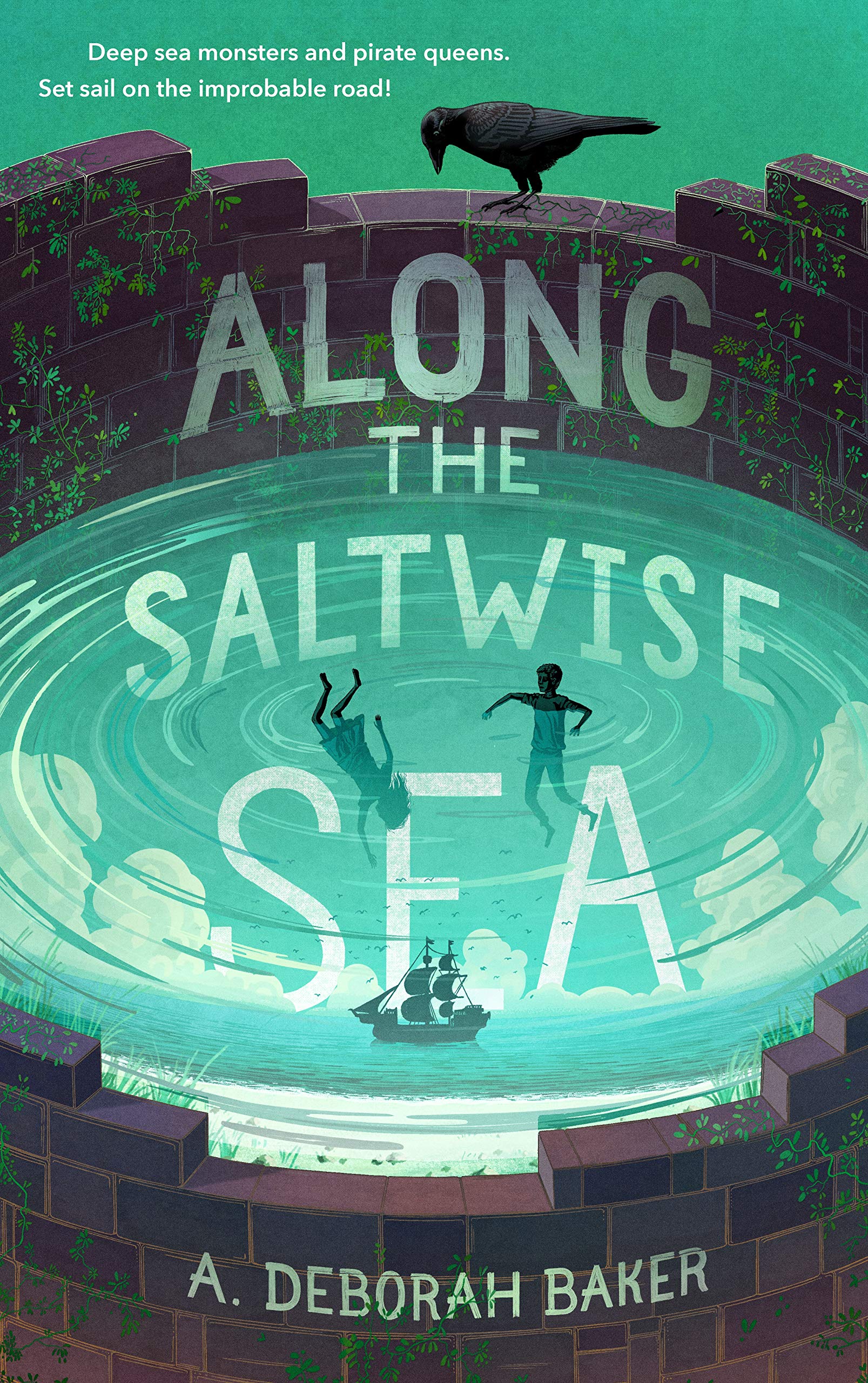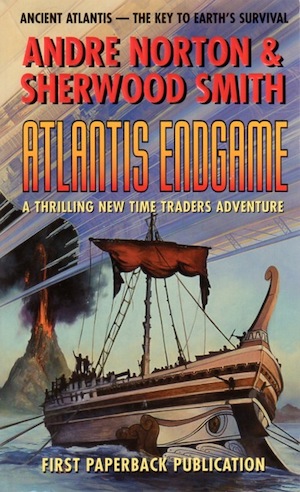When I’m reading a collaboration, I always catch myself trying to see which of the collaborators wrote which part of the book. Sometimes it’s easy—maybe even too easy if the two or more talents don’t mesh. Other times, it may not be possible to detect the specific contributions to individual scenes and plot elements, but if I know the authors’ solo works, I can guess at which aspects belong to which contributor. A really successful collaboration makes the most of its authors’ strengths, and the result is a work that neither might have produced on their own. It’s a best of both (or more) worlds.
Atlantis Endgame, for me, is one of those successes. Whereas Sneeze on Sunday reads like a Hogarth novel with very little Norton interpolation, this one seems to be a much more equitable combination of talents.
Sherwood Smith was (and is) a prolific writer in her own right. She has a substantial backlist of novels in science fiction and fantasy, both for adults and for younger readers, and she is the co-author with Dave Trowbridge of the epic space opera series, Exordium. She is particularly strong in characterization, which happens to be Norton’s great weakness.
That strength shines through here. Norton’s worldbuilding, her pacing, her mastery of action and adventure, combines well with Smith’s deeply humane view of the world.
Norton’s world view tends toward extremes. Good characters are not always all good, but bad characters are almost universally all bad. Her universe is strongly dualistic: light versus dark, good versus evil. Good is usually physically attractive and evil is usually (but not always) physically repulsive.
In the Time Traders universe, the good guys are generally human and usually from our time. The big bad is the Baldies, the (apparent) space aliens with their pasty white skins and hairless heads, who raid the human timeline and threaten the course of history. The series consists of the ongoing effort by time agents to conceal our time from the Baldies and to preserve the integrity of our particular timeline.
In Atlantis Endgame, the agents’ mission is to assure the destruction of the island of Thera, with a secondary mission to try to get the inhabitants to evacuate before the volcano blows. Thera has to go: if it doesn’t, human civilization won’t progress technologically to the point of achieving space travel. Earth will remain a peaceful, pastoral planet, isolated from the rest of the universe.
There’s a real moral ambiguity here, in that if the mission succeeds, technology will trash the planet, but the timeline in which Ross Murdock and his fellow agents live will be preserved. If the mission fails, none of them will exist, but the planet will be in much better shape, without the scars of war and industrial pollution. It’s a literal existential threat to Ross and his wife Eveleen and company on one hand, and to the Earth itself on the other.
The antagonists here are the Baldies, who are trying to suppress the eruption. A third element enters the mix once the agents pass through the time portal to the volcanic hellscape that is the city of Kalliste just before the cataclysm: the Fur Faces, or the Kayu, another alien race that has been opposing—and attacking—the Baldies across the universe.
The aliens have a very Norton feel to them, but Smith, I believe, adds a layer of complexity. She rehabilitates the Baldies by clarifying their reasons for what they do. They’re trying to save the universe from destructive spacefaring races by arresting their technological development. This also, and not incidentally, saves their planets from the ravages of war and pollution. Their mission is to preserve life and protect planetary ecologies.
The Kayu, who claim they are trying to save the future of Earth and the time agents, have blown up the Baldies’ sun and destroyed their planet. The Baldies have nearly been eradicated. And yet they persevere in their effort to stop the eruption.
Ross and Eveleen and their superior officer, Ashe, along with a pair of Greek agents, do their best to fulfill their mission. Ultimately it matters more to them that they continue to exist than that the Earth be saved from war and pollution. It’s a dark choice, and in its way a Norton choice; she had a ruthless streak, and her “good” characters were not always either nice or particularly benevolent.
The most interesting character in the novel, for me, is also rather intensely annoying: the middle-aged academic, Linnea, who more or less tags along in order to provide expertise in the culture and, to a very limited extent, the language of Kalliste. She has next to no training and it shows. She makes frequent mistakes, rides on false or wrongheaded assumptions, and treats the mission like a game or a guided tour. And yet she comes to realize that this world and its people are real, and she connects with a group of priestesses who tend the oracle on the island.
Buy the Book


Along the Saltwise Sea
Norton often wrote of groups of powerful female religious and magical leaders, notably the Witches of Estcarp. The priestesses have echoes of these as well as of the Wisewomen of the Dales and the devotees of Gunnora, with a more distant recollection of the Moonsingers of Yiktor. They’re also reminiscent of Smith’s girl gangs and her celebrations of female friendship. In their way they’re an antidote to the predominantly male and heavily action-oriented agents and their antagonists, both the Baldies and the Kayu.
Linnea maintains her distance from the priestesses, spending most of her time inside her own head, but the priestesses treat her as a peer. She learns the hard way that she is not necessarily the superior being that she likes to think she is, nor are the priestesses the superstitious primitives she has been seeing—and treating—them as. It’s a strong wake up call for her, and a shock to her world view. To her credit, she embraces it. In the end, she signs on to be a time agent.
I’m not sure the novel really addresses the problem of letting the earth be trashed in order to keep the time agents alive. It does require Ross and his fellow agents to make choices and take actions that will result in millennia of tragedy and violence. In some ways it might have been a more intriguing novel if they had chosen the Earth over themselves. But that wouldn’t have been a Norton novel. The inevitable must happen. The protagonists must win. The timeline must prevail.
As a collaboration, I think it works well. Smith adds depth to the characters, and brings the prose up a notch or two as well. The visuals, the descriptions, the emotional arcs, are vivid and memorable, even as the action races along and the tension ratchets up and up. It’s a great read and a rousing adventure—just as it needs to be.
I’m not going to read all the collaborations, but I do want to take on one more with Smith, this one in the Solar Queen universe: Derelict for Trade. I like the Solar Queen books, and I’ll be interested to see what Smith adds to the series.
Judith Tarr has written historicals and historical fantasies and epic fantasies and space operas, many of which have been published as ebooks. She has won the Crawford Award, and been a finalist for the World Fantasy Award and the Locus Award. She lives in Arizona with an assortment of cats, a blue-eyed dog, and a herd of Lipizzan horses.










